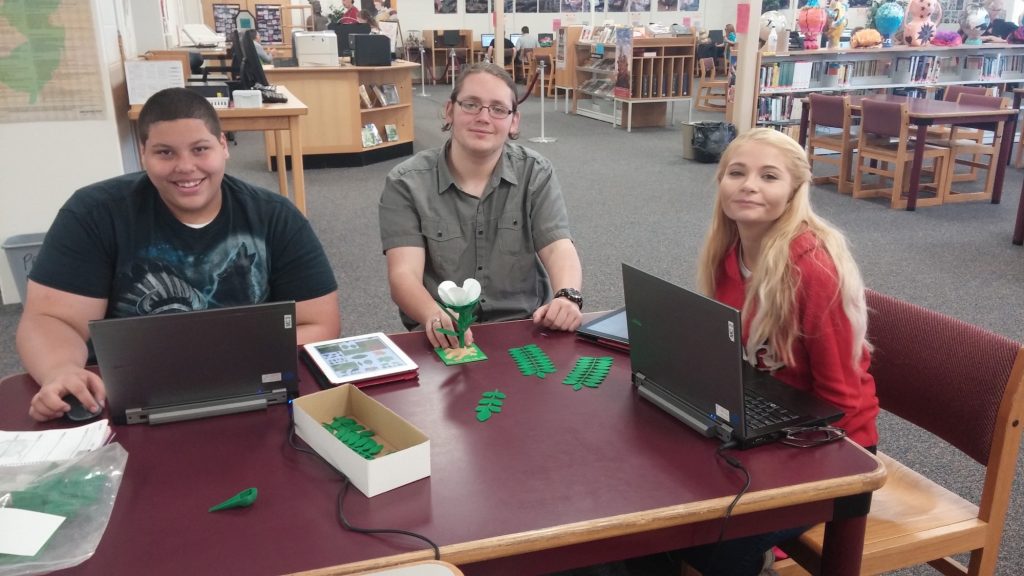VILLAS – Several Lower Township High School students are feeling “accomplished” after participating in a project aimed at helping fellow students with special needs.
Austin Berry, Autum Jordan, Brandon Hankins, Chayanne Rivera and Josh Rhuberg spent class time over about seven weeks recently designing and building a plant using three-dimensional (3-D) modeling that will help students with special needs better understand science.
They are second-year students of Joan Dilling’s, a horticulture teacher at the high school. Students take her class as an elective or as a science, and part of the course includes learning the parts of a flower to better understand its reproductive structure.
“When you can feel a leaf and its veins, and see it, you can learn better,” Jordan said. “This project made me feel accomplished knowing that I am helping people that have difficulty with learning.
“I actually learned something as well,” she added, “by learning how to use the 3-D printer and seeing how you design all the pieces and then put it together.”
Tish Carpinelli, school media specialist, manages two 3-D printers for any student or teacher to use. They are located in the Media Center so they are accessible to all students, regardless of their classes. This accessibility is what made it possible to collaborate with Dilling’s science class.
Carpinelli reached out to the faculty to see if anyone was interested in a project using the 3-D printer in the classroom this past year. Dilling raised her hand, and the two figured out how to incorporate it into the curriculum.
“Some of the kids are computer savvy, so they took right to it,” Carpinelli said about the second-year students, “while others learned how to use the programs as part of the project. Computer designing is not for everyone because there is a learning curve and it takes patience to keep working at it to make things right. That can be very frustrating for some students.”
One student who does animation in his off hours is Hankins, who thought the project was a “good idea. It was fun at first, but sometimes got to be very frustrating,” he said. “In the end, it turned out really good. It was frustrating at times when we had to re-do pieces because they needed to fit together precisely. If the size was off or a hole was not in the exact place where it needed to be, we had to re-do it.”
Rivera also said he felt good about the project because it not only helped other students, but he learned how to use the computer program as well. “It was fun to do this, but it also was frustrating because when you design by the computer, everything has to be very precise so it all fits together. Some things we had to re-do several times.”
The students designed the flower by its individual parts. Using iPads with photographs for reference, the team used one software program to draw the leaves. Another was used to give the leaves and flower petals shape and another was used for the root structure.
Once all the files were completed, they were integrated to print the final product. Filament is fed to the printer through a tube at about 215 degrees Fahrenheit before it is printed and molded into the final product design. The software program dictates the shape to the printer. Rivera used water to shape the leaves in a process called thermoforming.
“It was a good problem-solving exercise for the students,” Carpinelli said, “because they needed to measure and figure out how everything would fit together as they scaled some of the parts.”
It was the first time Dilling used the 3-D printer in the classroom. “While the students can see plants and leaves in the greenhouse, sometimes we don’t have anything growing in the winter,” she said. “This provided us with a good way to challenge some of my students with a project whose end result will help other students who need this information as part of their curriculum.”
Dilling said she was pleased with the project results. “I would absolutely use the 3-D modeling and printer again. When you see a picture of a plant, it’s flat; you don’t get to see its dimensions. All this helps with understanding science. It also helps to stretch and motivate other students by giving them something challenging to work on.”
Hankins added that another benefit was that the project can last beyond next year’s students. “Because it’s a program and we saved our designs, we can re-use it many times,” he added. “This way it can help students next year and after that.”
To contact Karen Knight, email kknight@cmcherald.com.







